October was a month that kept investors on their toes, with plenty of moving parts across asset classes and regions.
Equities had another strong run, especially in Emerging Markets and Asia ex-Japan which rose by over 6% in both cases. Domestic demand, AI-driven tech momentum, and supportive monetary policy were the main drivers. The US market was led by the “Magnificent Seven” mega-cap tech stocks – illustrated by the strong performance of the NASDAQ index – whose Q3 earnings were robust, particularly in cloud and AI segments. Their performance lifted the S&P 500, even as some of the broader index constituents lagged. The ongoing US government shutdown was a headline risk, but so far hasn’t overly dented market performance.
Chinese equities were notable laggards in October, falling by around 1.5% and taking a bit of a breather from the very strong performance seen in August and September. Still, as mentioned above, broader EM and Asian markets were very strong, with India, Taiwan, and South Korea all posting impressive gains. Japanese equities also posted handsome gains, helped by a weaker yen and a surprise pro-stimulus election result.
UK equities also underperformed, and particularly domestically focused stocks as represented by the FTSE 250 index which rose by just 0.3%. UK macroeconomic data were soft, with GDP and PMI readings disappointing, and inflation remained stubbornly above target. More attention will turn to UK assets next month as the upcoming budget on 26th November is eagerly anticipated.
Bond markets were generally positive as well. Here, UK assets were the standout performers, with UK Gilts rising 2.9% – their best month in nearly two years thanks to softer than expected (though still high) inflation data and expectations for Bank of England rate cuts, and investment grade corporate bonds rising by 2.2%.
At the other end of the spectrum, while still positive, US assets were relatively weak as they gave up some of the previous months’ outperformance. While the Federal Reserve cut interest rates as expected, and announced an end to ‘Quantitative Tightening’, the rhetoric from Jerome Powell was more hawkish than expected on forward looking policy, which disappointed markets somewhat:
On the macroeconomic front, the global backdrop remains supportive for risk assets. US economic data pointed to moderation, with GDP growth slowing but still resilient. Headline inflation ticked up slightly, while core inflation eased marginally, reinforcing expectations for further monetary support. As mentioned, above the Fed’s rate cut was widely anticipated, but Chair Powell’s cautious tone on future policy disappointed some market participants.
In the UK, GDP grew just 0.1% in August after a similar decline in July, while unemployment edged higher and inflation held steady at 3.8%, marginally below forecasts. Subdued growth expectations and positioning ahead of November’s Budget pushed Gilt yields to three-month lows. In Europe, inflation moderated further to 2.1% in October, moving close to the ECB’s target and reinforcing expectations that policymakers will maintain their patient stance.
US fiscal and tariff policies remained central to the macro narrative. While major, market-moving tariff headlines are less frequent than earlier in the year, protracted negotiations most notably with China still have the potential to surprise positively or negatively, and must be closely watched.
The US federal government shutdown began on 1st October, with major services shuttered and workers furloughed. The primary dispute is ostensibly centred around healthcare spending, and while shutdowns aren’t uncommon, at the time of writing this one is notable for now being the longest in history, currently spanning 38 days:
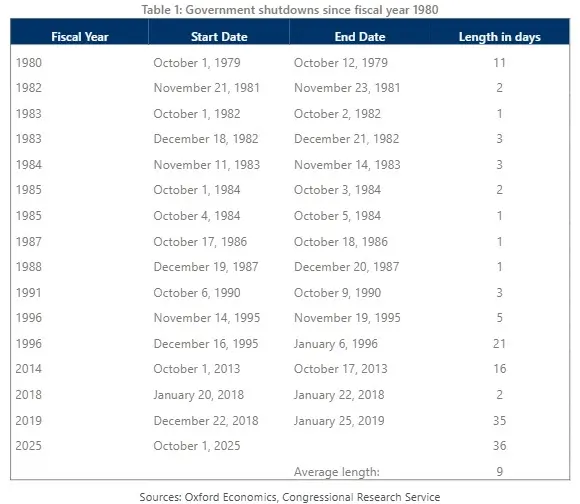
Each week of shutdown is estimated to reduce annualized GDP growth by 0.1–0.2 percentage points, or up to $15bn per week, and the longer the shutdown persists, the greater the risk to government-funded programs and investor sentiment. Markets have largely looked through the headline risk so far as most of the damage caused by the shutdown will be reversed as federal employees receive back pay, delayed federal contracts are finally approved, and social benefits like SNAP resume in full.
However, the lack of government data makes it difficult to determine whether there have been significant spillover effects from the shutdown into the private sector. For example, jobless claims data point to some private-sector layoffs in States most exposed to the shutdown, but the full impact will only be known once the government reopens for business.
Overall, October reinforced the importance of agility and vigilance in portfolio management. While markets have shown resilience, the interplay of monetary policy, fiscal dynamics, and geopolitical risk continues to drive volatility and opportunity. We remain constructive but cautious, favouring quality, diversification, and active risk management as the global landscape evolves.
For a more detailed look at this month’s update, listen to our Market Update podcast. Join Investment Director Oliver Stone and Portfolio Manager Harry Scargill as they break down the key market developments shaping October. From equities and fixed income to macroeconomic trends and the evolving policy landscape, our experts share timely insights to help you navigate the months ahead.
We have over 1250 local advisers & staff specialising in investment advice all the way through to retirement planning. Provide some basic details through our quick and easy to use online tool, and we’ll provide you with the perfect match.
Alternatively, sign up to our newsletter to stay up to date with our latest news and expert insights.
| Match me to an adviser | Our advisers |
The value of investments may fluctuate in price or value and you may get back less than the amount originally invested. Past performance is not a guide to the future. The views expressed in this publication represent those of the author and do not constitute financial advice.
September saw a continuation of the year’s risk-on momentum, with global equities posting strong gains. The S&P 500 returned 3.7%, marking its best September in 15 years—a notable feat given the month’s historical volatility. The NASDAQ outperformed, up nearly 6%, as US tech stocks benefited from AI-driven optimism and resilient earnings.
China’s equity market led major regions, rising 7.6%, propelled by policy support for domestic chipmakers and a surge in AI investment. The Hang Seng Tech Index gained 22% for the quarter, with Alibaba and TSMC posting outsized monthly gains.
Japan’s Nikkei rose 3.1%, supported by a weaker yen, ongoing corporate reforms, and a surprise prime ministerial election result that markets interpreted as pro-stimulus. The new PM’s victory triggered a sharp rally in equities in early October, though long-dated JGB yields and the yen weakened on renewed fiscal concerns.
UK equities lagged, with the FTSE 100 and 250 up just 1.3–1.4%. Domestic macro data disappointed, with GDP and PMI readings softening, and inflation remaining stubbornly above target. European equities posted modest gains, but French political risk resurfaced, threatening deficit reduction plans and pressuring the bond market:
Precious metals were the standout asset class. Gold surged 11% in GBP terms, trading near $3,900/oz—a new all-time high. Silver rallied 14.6%, approaching its 2011 peak of $50/oz. The rally was driven by a confluence of factors: lower real yields, a weaker US dollar, persistent inflation, and heightened geopolitical risk. Central banks, notably China, continued to accumulate bullion, while private investors poured record inflows into gold-backed ETFs:
The technical picture for gold and silver is stretched, with prices having doubled in less than two years. While the medium-term outlook remains constructive, near-term consolidation is possible given the speed and magnitude of recent gains.
Bond markets stabilised in September, with US Treasuries up 1% as the Fed delivered a dovish rate cut. Investment grade corporate bonds outperformed; particularly those US denominated, benefiting from spread compression, while high yield lagged slightly as spreads widened modestly.
Long-dated government bond yields remained below August highs, but the UK’s 30-year Gilt yield reached 5.6%, its highest since the late 1990s, underscoring persistent worries about fiscal sustainability.
The main macroeconomic headline in September was the Federal Reserve’s pivot to monetary easing; cutting rates by 25bps and signalling scope for further cuts this year. The decision was framed as risk-management, with downside risks to employment outweighing inflation concerns. The ECB and BoE held rates, maintaining a cautious tone and emphasising data dependence. The Bank of Japan stood pat but delivered a hawkish message, only to see expectations upended by the election result.
US fiscal and tariff policies remained central to the macro narrative. The trade-weighted tariff rate now exceeds 18%, reminiscent of 1930s levels, but actual duties paid are still catching up. The growth and price impacts of tariffs are likely to intensify in coming quarters, with baseline US growth expectations remaining resilient for now.
The US federal government shutdown began on October 1, with major services shuttered and workers furloughed. The primary dispute centres on healthcare spending. While shutdowns are not uncommon, the current episode is notable for its potential duration and the administration’s threat of permanent layoffs in federal departments. Per Oxford Economics’ analysis, each week of shutdown is estimated to reduce annualised GDP growth by 0.1–0.2 percentage points, or up to $15bn per week. The longer the shutdown persists, the greater the risk to government-funded programmes and investor sentiment.
Markets have largely looked through the headline risk so far, focusing on the rate path and incoming data, though delays in key economic releases (e.g., jobs and inflation) could increase uncertainty.
The overall environment remains moderately supportive for risk assets, with steady growth, stable (if elevated) inflation, and central banks signalling further easing. However, uncertainty is elevated, and policy decisions will remain data-dependent.
Careful monitoring of economic indicators, policy signals, and geopolitical developments will be essential in the months ahead. While conditions remain broadly constructive, prudent risk management and portfolio diversification are warranted.
Overall, September 2025 reinforced the importance of agility and vigilance in portfolio management. While markets have shown resilience, the interplay of monetary policy, fiscal dynamics, and geopolitical risk continues to drive volatility and opportunity. We remain constructive but cautious, favouring quality, diversification, and active risk management as the global landscape evolves.
For a more detailed look at this month’s update, listen to our Market Update podcast. Join Portfolio Manager Imogen Hambly and Investment Director Oliver Stone as they break down the key market developments shaping September.
We have over 1250 local advisers & staff specialising in investment advice all the way through to retirement planning. Provide some basic details through our quick and easy to use online tool, and we’ll provide you with the perfect match.
Alternatively, sign up to our newsletter to stay up to date with our latest news and expert insights.
| Match me to an adviser | Our advisers |
The value of investments may fluctuate in price or value and you may get back less than the amount originally invested. Past performance is not a guide to the future. The views expressed in this publication represent those of the author and do not constitute financial advice.
August delivered a mixed but generally resilient performance across global markets. Equities absorbed tariff headlines and political noise to post modest gains overall, though leadership rotated meaningfully. Japan outperformed, rising around 4.8% in GBP terms, supported by a weaker yen and tariff relief for automakers. In contrast, UK equities lagged, with the FTSE 250 down nearly 2% amid domestic policy uncertainty, a surprise inflation uptick, and renewed speculation over potential government revenue-raising measures.
Continental Europe eked out a small gain (1.3%) but lost momentum into month-end as French political risk resurfaced following the Prime Minister’s surprising announcement of a confidence vote on 8th September. Given the administration’s lack of support in parliament, he’s likely to lose the vote which means President Macron will then have three options: call for a new parliamentary election; ask the PM to stay in charge of a caretaker government; or nominate a new prime minister. The last option is probably the most likely and would just about keep the plates spinning, but would likely stymie the deficit reduction plans for 2026 and continue to put pressure on the French bond market.
Precious metals were standout performers this month standout. Gold tested new highs near $3,500/oz, and silver broke $40/oz for the first time since 2012, reflecting a combination of policy uncertainty, softer late-month US dollar tone, and demand for hedges.
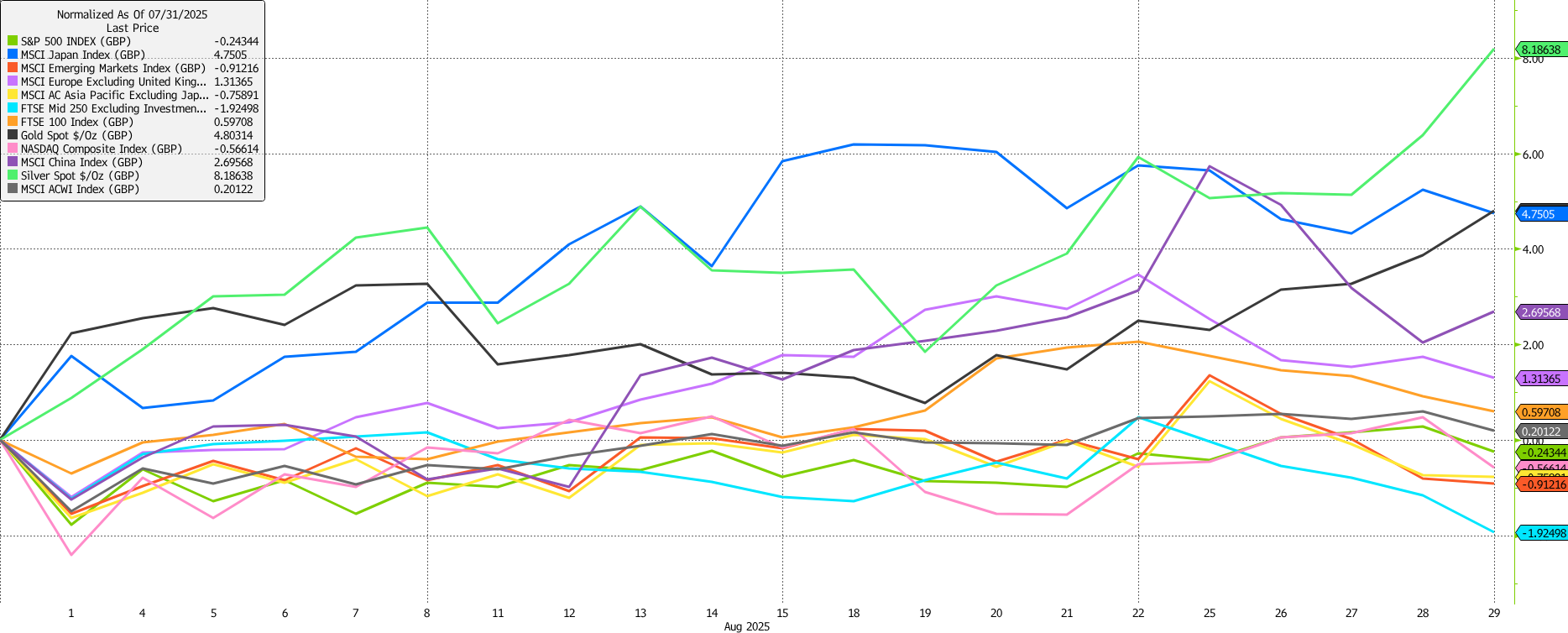
Style and size factors diverged: value outperformed growth, aided by higher long-dated government bond yields and general sector composition, while small caps rallied on expectations of earlier US Federal Reserve easing following Chairman Jerome Powell’s Jackson Hole Symposium remarks. Mega-cap growth names faced idiosyncratic pressure; most notably NVIDIA, where strong absolute results were overshadowed by slowing growth rates and potential tariff-related headwinds.
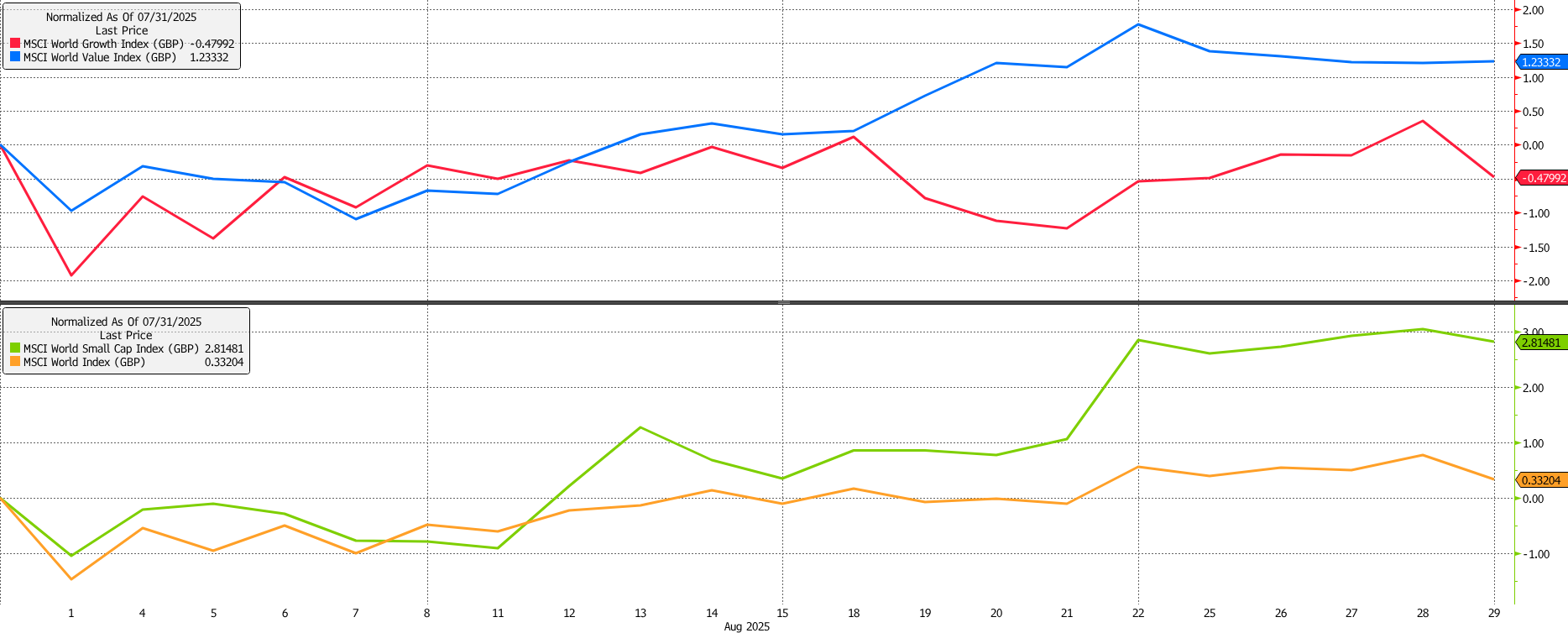
In fixed income, US Treasuries posted positive returns (1%) as yields dropped on dovish Fed signals, while global high yield bonds were once again the best performers, benefitting from their risk-on link to equities and gaining 1.1% on continued spread compression.
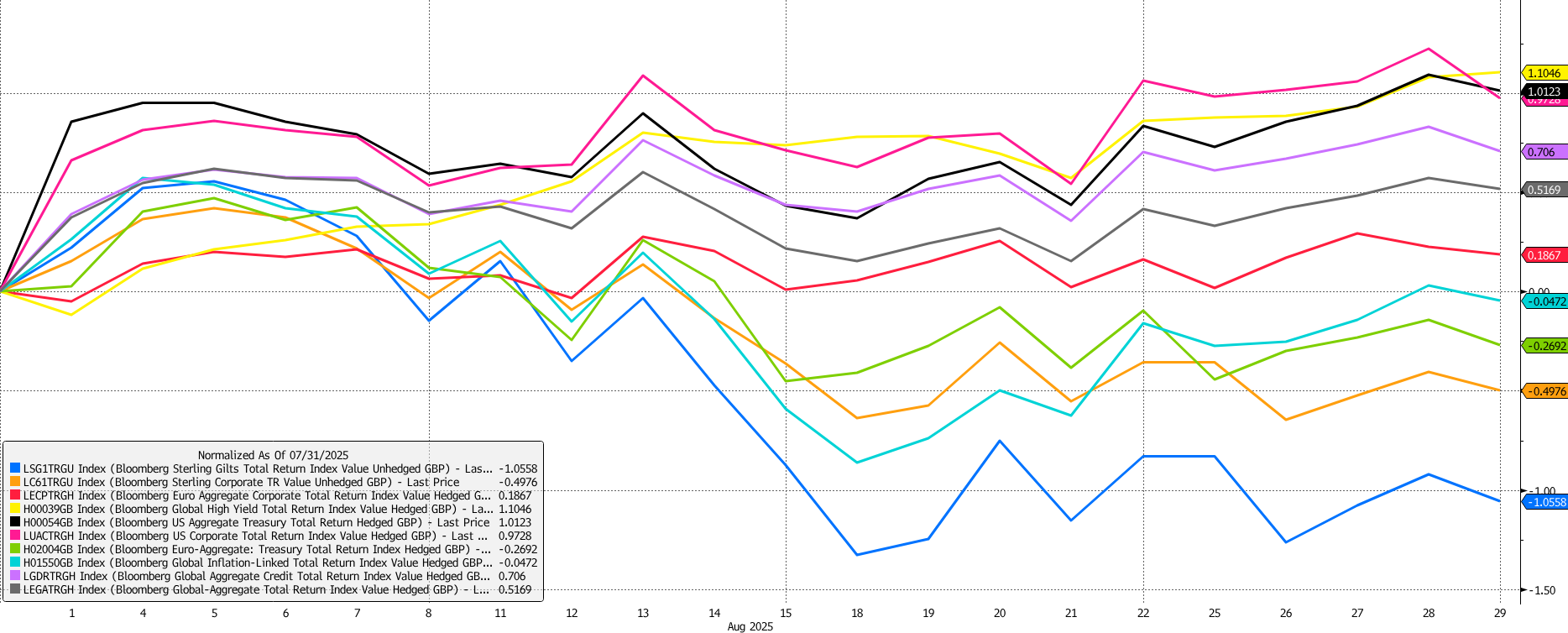
Gilts were a notable underperformer, falling by 1.1% as particularly longer maturity yields rose. 30-year Gilt yields reached 5.6%; their highest since the late 1990s.
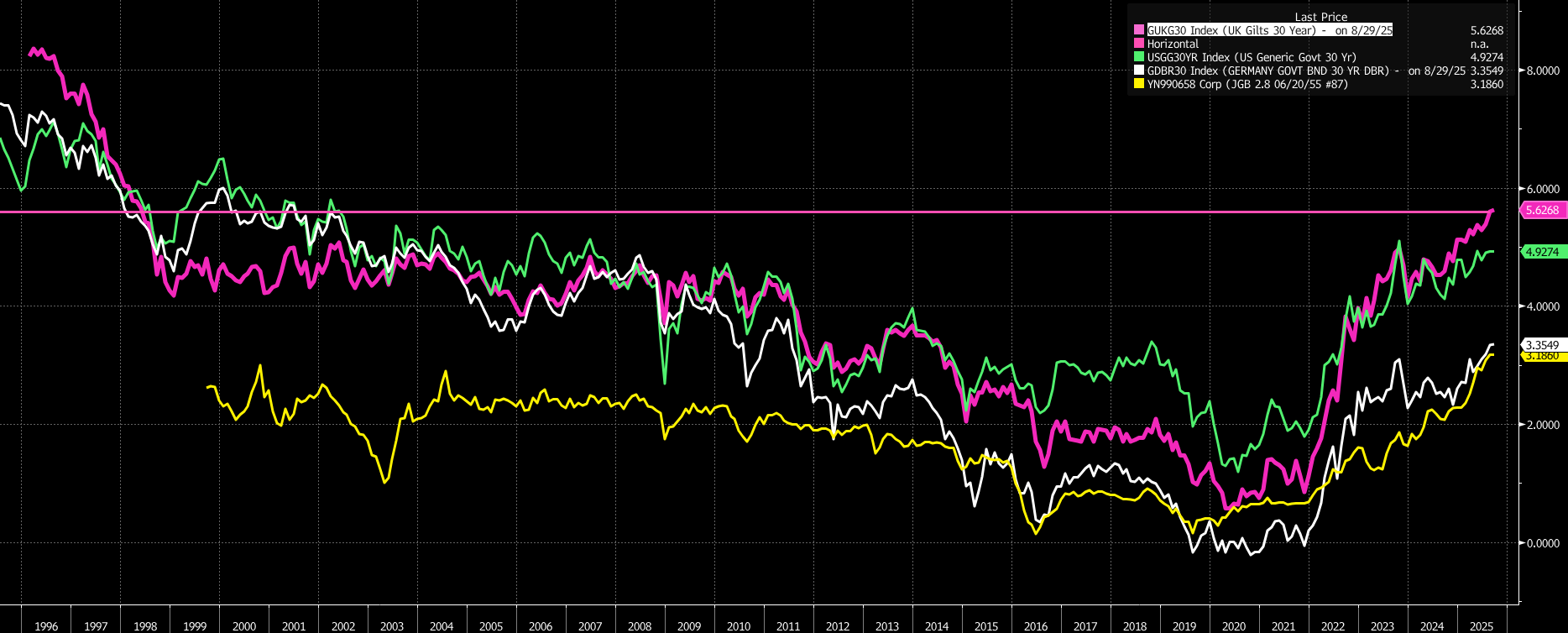
In the US, as noted above, Jerome Powell’s Jackson Hole speech really moved the dial as he heavily implied that a rate cut is coming in September, while placing more emphasis than before on the relative weakness of the labour market. Meanwhile, the threat of tariffs disruption remains a spectral presence in markets; the announced, trade weighted rate is now north of 18%—a 1930s style headline—but duties actually paid are still catching up. This means that some of the growth and price impacts are likely still ahead, not behind us. Even so, baseline US growth expectations haven’t fallen, which helps explain why risk assets have remained resilient.
We saw a different narrative unfold in the UK. The Bank of England cut interest rates by 0.25% to 4.0%, but the vote passed on a knife edge, and the tone of the Monetary Policy Committee’s comments were hawkish enough to keep a lid on bond market enthusiasm.
The overall environment remains moderately supportive, but uncertainty is elevated. Growth is steady in most regions, inflation is stable if still above targets, and central banks are still on balance signalling a shift toward lower rates. However, policy decisions will remain data‑dependent, and political developments—covering trade policy, fiscal pressures, and governance—could influence market sentiment. We expect conditions to remain broadly constructive, but risks are meaningful; careful monitoring of economic indicators and policy signals will be important in the months ahead.
For a deeper dive into August’s market performance, listen to our Market Update podcast as Portfolio Manager, Harry Scargill, and Investment Director, Oliver Stone, CFA, break down the major movements and developments.
We have over 1250 local advisers & staff specialising in investment advice all the way through to retirement planning. Provide some basic details through our quick and easy to use online tool, and we’ll provide you with the perfect match.
Alternatively, sign up to our newsletter to stay up to date with our latest news and expert insights.
| Match me to an adviser | Our advisers |
The value of investments may fluctuate in price or value and you may get back less than the amount originally invested. Past performance is not a guide to the future. The views expressed in this publication represent those of the author and do not constitute financial advice.
July was a month of cautious optimism across global financial markets. Risk assets broadly moved higher, central banks struck a more dovish tone, and geopolitical tensions—while still present—showed signs of de-escalation. Yet beneath the surface, the macroeconomic and policy landscape remains complex, with trade dynamics, inflation trajectories, and fiscal pressures continuing to shape investor sentiment.
Global equities delivered strong returns, building on the momentum from Q2. Chinese equities led the way, gaining over 8% in GBP terms and recovering some of the lost ground seen this year after tariff-related relief. The NASDAQ was also strong, up around 7.5% in GBP terms, fuelled by robust earnings from large-cap tech and AI-focused firms. Encouragingly, market breadth improved, with the equal-weighted S&P 500 rising 3.5%, suggesting the rally extended beyond the usual mega-cap suspects.
UK equities also had a good month in absolute terms, with the large-cap FTSE 100 gaining 4.2%, benefitting from its commodity-heavy composition which saw better earnings and a brighter outlook for energy and materials:
Bond markets were more subdued. Early-month weakness gave way to an anaemic rally in the latter two weeks of July, but government bond yields remain stubbornly high, driven by still-robust economic data and increased government debt issuance. For the most part, this left returns broadly flat to modestly negative across fixed income.
In the UK, the 10-year gilt yield edged up from 4.45% to 4.53%, reflecting persistent inflation and fiscal concerns. The Bank of England’s decision to cut rates by 25bps to 4% was narrowly passed, with a second round of voting required. The MPC’s messaging remains mixed, balancing signs of labour market fragility with lingering inflationary pressures. While another cut in November is still expected, confidence in that call has waned.
Across the Atlantic, the Fed held rates steady at 5.25%, but July’s weaker-than-expected jobs report—alongside downward revisions to May and June—has raised the odds of an earlier rate cut. The unemployment rate ticked up to 4.2%, and the foreign-born labour force shrank significantly, reflecting the impact of Trump’s immigration policies:
Inflation data was a mixed bag. In the US, core CPI surprised to the downside, reinforcing disinflationary trends. However, headline inflation remains sticky, particularly in services and food. The UK saw an unexpected rise in headline inflation to 3.6%, the highest since January 2024. Despite this, markets still anticipate further rate cuts, driven by weakening labour market indicators and sluggish growth.
Europe’s inflation hovered around the 2% target, allowing the ECB to pause its easing cycle after eight consecutive cuts. The central bank’s dovish stance has helped anchor rate expectations, though fiscal challenges and trade uncertainty continue to cloud the outlook.
Trade policy remained a dominant theme. The Trump administration’s “One Big Beautiful Bill Act” and a flurry of trade agreements helped calm markets, but effective tariff rates are creeping higher again. As of August 1, the statutory tariff rate stood at 18.2%, up from 17% in July. While headline rates have moderated for many countries, exemptions and preferential deals mean the actual impact varies widely:
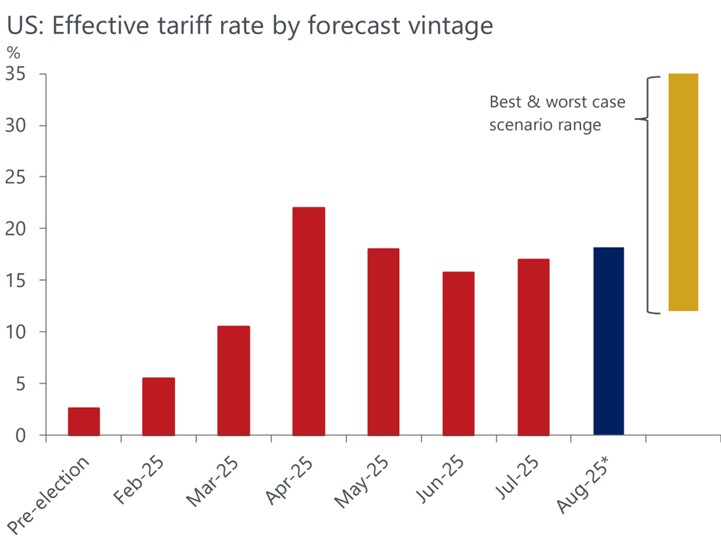
For a deeper dive in to the July update, listen to our podcast with Portfolio Manager Harry Scargill and Investment Director Oliver Stone as they break down the key market themes that shaped the month.
We have over 1250 local advisers & staff specialising in investment advice all the way through to retirement planning. Provide some basic details through our quick and easy to use online tool, and we’ll provide you with the perfect match.
Alternatively, sign up to our newsletter to stay up to date with our latest news and expert insights.
| Match me to an adviser | Our advisers |
The value of investments may fluctuate in price or value and you may get back less than the amount originally invested. Past performance is not a guide to the future. The views expressed in this publication represent those of the author and do not constitute financial advice.
June saw a broadly positive performance across equity markets, with most global indices rising as risk sentiment improved. This came despite escalating geopolitical tensions in the Middle East. US equities in the form of the tech-heavy NASDAQ index were the top performers, rising by 4.6% in pound terms, while the UK was a notable laggard, with the FTSE 100 posting negative returns of -0.13%, reflecting domestic macroeconomic and political concerns.
Silver prices surged nearly 9.5% during the month, beginning to catch up with gold’s performance which has been setting a series of new all-time highs over the past year. This pattern is typical in the early stages of a precious metals bull market and may continue if the trend persists:
This improved sentiment followed the delay in US tariff implementation, with President Trump signaling a willingness to negotiate. This helped reduce perceived recession risks among global corporates, although growth expectations still remain well below levels seen earlier in the year:
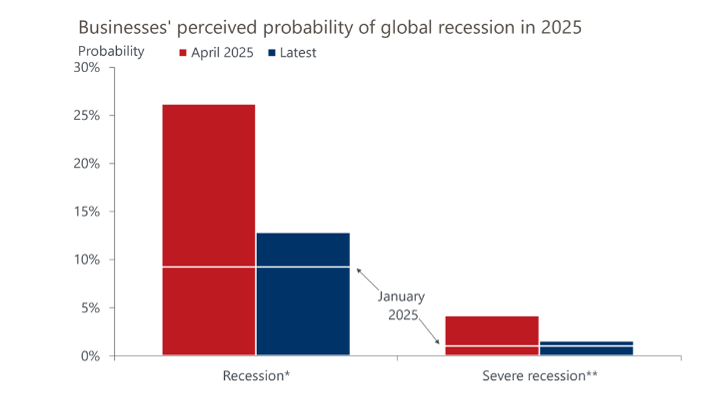
Bond markets were volatile. Sterling assets performed well during June as falling gilt yields (and therefore higher prices) reflected weaker macroeconomic data. However, a sharp drop in gilt prices occurred early in July following a session of Prime Minister’s Questions in which the Chancellor’s job security was questioned, serving to highlight the fragility of UK asset prices to political developments.
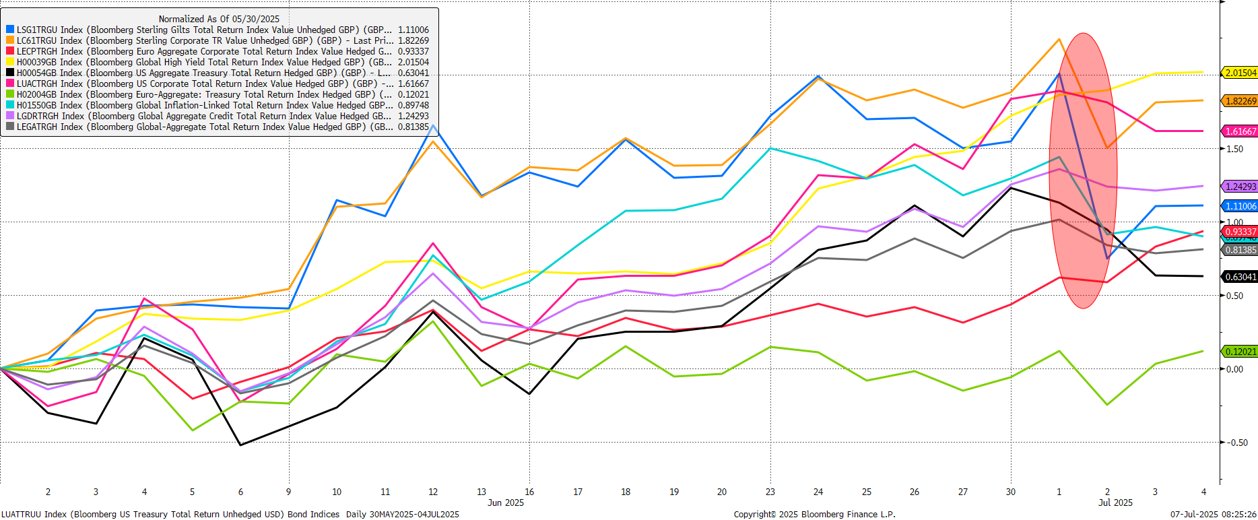
UK jobs data weakened further, with continued losses in cyclical sectors and high candidate availability reported by recruiters. This, combined with fiscal pressures, suggests the UK government may need to tighten policy by £20–30bn in the autumn budget, likely through further tax hikes and threshold freezes.
This places the government in a Catch-22 position; bond markets are expected to react negatively to any perceived fiscal loosening, but equity markets will likely react negatively to further fiscal tightening as animal spirits are crushed:
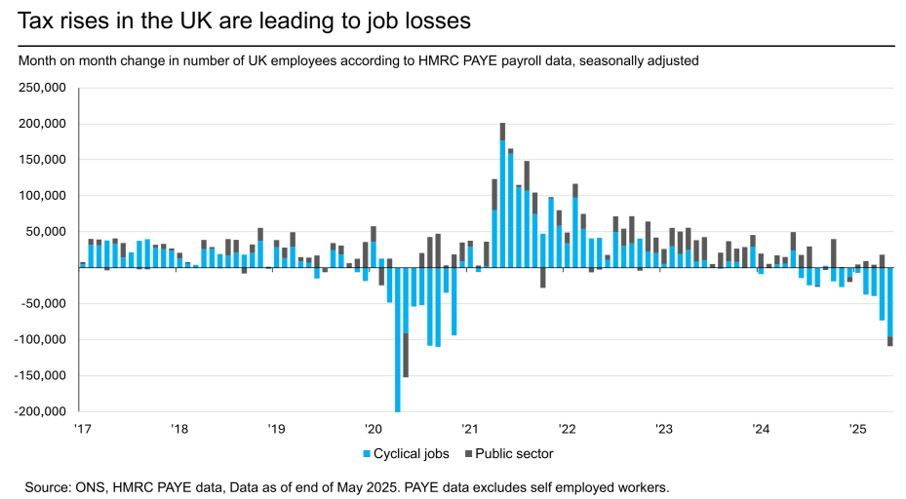
Geopolitical tensions escalated mid-month with Israel’s Operation Rising Lion and subsequent Iranian retaliation. The US intervened with Operation Midnight Hammer, but a ceasefire was reached within 12 days. Oil and gold prices spiked initially, but markets quickly stabilised, reflecting investor resilience to short-term geopolitical shocks.
Brent crude rose to nearly $80 per barrel during the conflict, driven by fears of supply disruption in the Strait of Hormuz. Although prices eased after the ceasefire, they remain elevated, reflecting a persistent geopolitical risk premium:
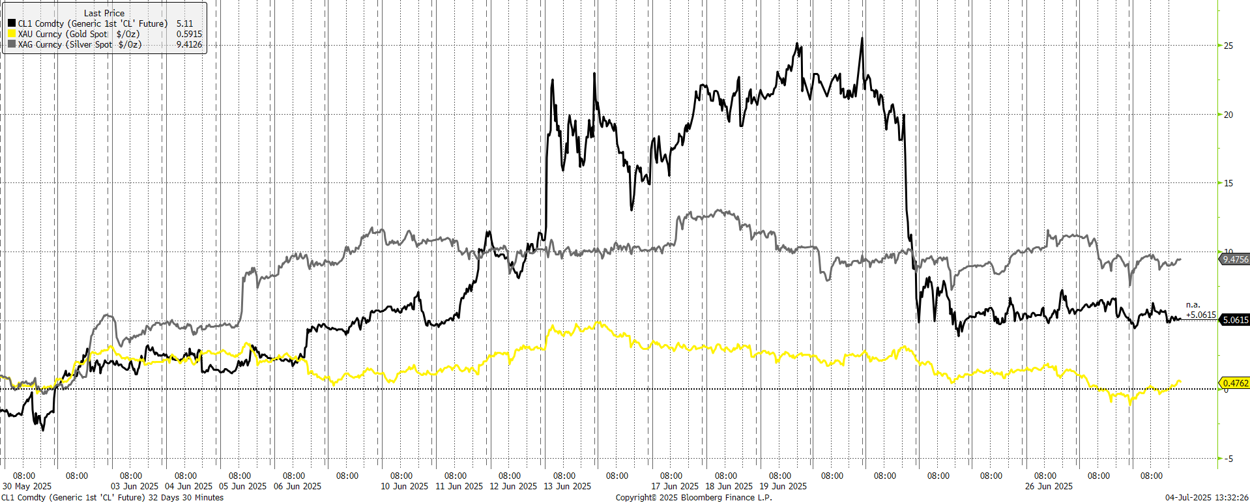
The US passed the One Big Beautiful Bill (OBBB), a major tax-and-spending package that will significantly widen the fiscal deficit. The deficit is expected to reach nearly 7% of GDP over the next few years, raising concerns about long-term fiscal sustainability. This has reinforced our preference for shorter-duration bonds:
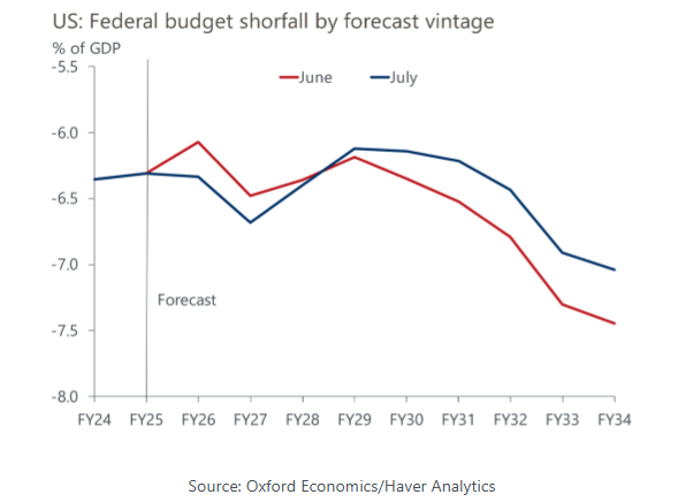
Tariff policy remains a key macroeconomic variable. The 10% universal tariff and other measures are expected to raise $2.5 trillion in revenue over the next decade. Given the president’s broad authority over trade policy, further changes could occur rapidly and without congressional approval. Retaliatory measures from other countries remain a risk, particularly in the form of non-tariff barriers.
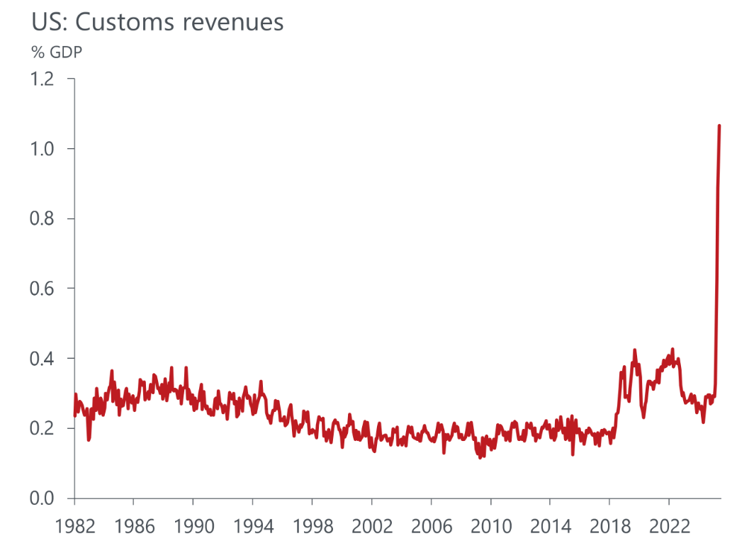
In summary, June was marked by strong equity performance, volatile bond markets, and significant geopolitical and fiscal developments. Diversification remains essential in navigating these complex dynamics and mitigating risks associated with market volatility and economic uncertainty.
For a deeper dive in to the June update, listen to our Market Update podcast where Portfolio Manager Imogen Hambly and Investment Director Oliver Stone unpack the key market events and trends.
We have over 1250 local advisers & staff specialising in investment advice all the way through to retirement planning. Provide some basic details through our quick and easy to use online tool, and we’ll provide you with the perfect match.
Alternatively, sign up to our newsletter to stay up to date with our latest news and expert insights.
| Match me to an adviser | Our advisers |
The value of investments may fluctuate in price or value and you may get back less than the amount originally invested. Past performance is not a guide to the future. The views expressed in this publication represent those of the author and do not constitute financial advice.
May was marked by significant market movements and a continued complex macroeconomic and geopolitical landscape. Equity markets experienced a notable rally, driven by a temporary pause in US-China tariffs and a US court ruling that initially blocked most of Trump’s global tariffs. This led to substantial gains in US equities, with the S&P 500 futures up 5% and the Nasdaq 100 up 8.7% in GBP terms.
Strong earnings reports from major tech companies, particularly Nvidia, further boosted investor confidence in the tech sector, contributing to the overall market gains. However, the temporary trade truce also impacted other asset classes, with precious metals like gold and silver experiencing relative weakness as investors shifted their focus to equities and other riskier assets.
The FTSE 250 index also performed well, rising by 6.5% over the month, benefiting from strong earnings reports, positive economic data, reduced trade tensions, and positive sector performance in technology and consumer goods. The Bank of England’s decision to cut the Bank Rate by 0.25% to 4.25% also positively impacted market sentiment, further supporting the index’s performance.
In the UK more generally, macroeconomic data has been relatively strong, with GDP growth surprising to the upside and retail sales remaining robust. The Bank of England has continued to cut rates and has upgraded its growth forecasts for the year. The UK government announced trade deals with India and the US, which, while not game-changing for growth, are positive developments in an increasingly fragmented global trade landscape. However, there is scepticism among economists about the true level of underlying economic strength, with concerns about inflation surprising to the upside, increased government borrowing, and the potential for fiscal policy to tighten again in October’s budget.
In global currency markets, the pound strengthened versus most major currencies, driven by positive economic data, while the US dollar index initially rose before selling off again during the month, despite positive market sentiment following the US-China trade truce.
The bond market saw a reversal of last month’s moves as risk appetite returned, with riskier credit outperforming safer government bonds. Inflation surprises to the upside and continued upward pressure placed on yields by investors, who are pricing in a medium-term outlook of higher inflation driven by overly loose fiscal policy, also influenced bond market movements.
US treasuries suffered a credit rating downgrade from Moody’s, and UK gilts fell in value despite the Bank of England’s rate cut. Longer-dated bond yields, particularly the 30-year tenor, moved significantly higher over the month, reflecting market concerns over growth and inflation outlooks. The US 30-year Treasury yield hovered near 5%, similar to the UK and Germany, highlighting the caution required in fixed income allocations.
The US tariff policy continues to be a major driver of global financial market sentiment and returns. The 90-day pause for most tariffs between the US and China brought the overall effective US tariff rate down to 15%, from the previous 21-22% level. However, the outlook remains extremely uncertain, with both sides accusing each other of not adhering to the agreed terms. This uncertainty has led to increased market volatility, with investors closely monitoring any developments in the trade negotiations.
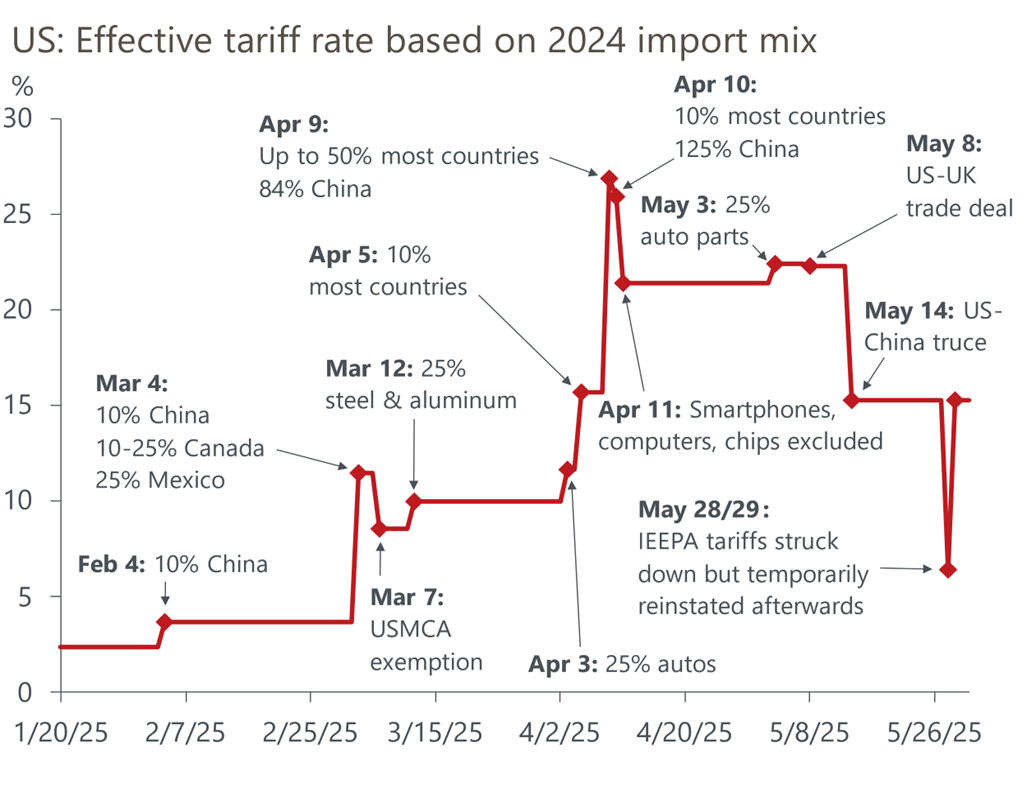
Overall, the financial markets remain highly sensitive to developments in US trade policy, economic data, and geopolitical machinations, and we remain intensely focused on developments here as we expected volatility to remain elevated across asset classes.
As always, portfolio diversification will be crucial in mitigating risks associated with market fluctuations and economic instability. By adopting a strategic approach that emphasises diversification, we can help to guide you through these uncertain times and ensure that investment portfolios are well-positioned for long-term success.
To take a deeper dive into the May update, listen to our Market Update podcast where Portfolio Manager, Harry Scargill and Investment Director, Oliver Stone discuss key market events and trends throughout May 2025, covering everything from equity market rallies to sector highlights as well as an update on global trade policies.
We have over 1250 local advisers & staff specialising in investment advice all the way through to retirement planning. Provide some basic details through our quick and easy to use online tool, and we’ll provide you with the perfect match.
Alternatively, sign up to our newsletter to stay up to date with our latest news and expert insights.
| Match me to an adviser | Our advisers |
The value of investments may fluctuate in price or value and you may get back less than the amount originally invested. Past performance is not a guide to the future. The views expressed in this publication represent those of the author and do not constitute financial advice.
April 2025 was a month marked by significant volatility and uncertainty across global financial markets. The primary driver of this turbulence was the announcement of sweeping tariffs by the US administration, which had far-reaching implications for trade, economic growth, and investor sentiment.
Global equity markets experienced substantial swings throughout April. The initial tariff announcements on April 2nd triggered a global sell-off, with US stocks plunging by over 10% at one point and a surge in the VIX volatility index. However, markets calmed later in the month after some US policy moderation and better-than-feared corporate earnings results. The S&P 500 ultimately closed down around 4% in GBP terms, while the tech-heavy NASDAQ outperformed despite starting the month weakly, falling by 2.5%. Ex-US developed markets outperformed strongly as capital flowed towards the UK, Europe, and Japan, continuing the trend of the previous three months. China, seen as the nation worst affected by US policy, was the weakest in GBP terms:
Gold performed exceptionally well in April, rising by more than 5% in GBP terms (black line above). Gold’s role as a safe-haven asset was reinforced by broader economic uncertainties and geopolitical tensions, with investors continuing to turn to the precious metal as a hedge against potential market downturns and inflationary pressures. The chart below shows the performance of various asset classes relative to a standard 60/40 equity/bond portfolio during periods of low growth and high inflation since 1974, and clearly illustrates that gold has consistently outperformed other asset classes in those periods, achieving the highest positive returns. In contrast, assets like the S&P 500 and government bonds have struggled, often showing negative or minimal returns.
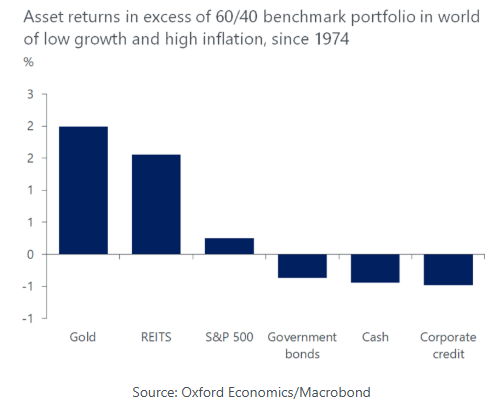
Currency markets were also strongly impacted by the tariff announcements, with movements here being a key component of equity returns when translated back into GBP. The US dollar, which would usually be expected to appreciate in an uncertain macroeconomic environment, sold off heavily vs all major currencies; the black line below charts the performance of the dollar index (DXY) which is a trade weighted index of developed market currencies vs the USD. Over April this gauge fell by 7.%, with notable underlying drops vs the Euro and Yen.
Global government bond markets saw initial rallies into the teeth of April’s uncertainty, followed by a concerted sell-off as investors priced in additional inflation concerns linked to the impact of US tariff policies. Some recovery was seen later in the month as policy moderated, but per the chart below, investment grade and high yield corporate debt underperformed government bonds over the month, while US assets underperformed European and UK counterparts. Despite signs of growth weakening in the US, the Federal Reserve has been clear that they won’t cut rates until the weakness is apparent in macroeconomic data due to inflation risks. This means less positivity at the margin for US bonds:
As mentioned above, one of the key themes in April was the impact of US tariff measures on the global economy. Observed levels of US trade policy uncertainty were extremely high as the chart below shows, and this uncertainty is expected to persist into the third quarter of 2025, adding to concerns about a potential growth slowdown, especially as the full shock from tariffs hasn’t fully hit macroeconomic and earnings data yet:
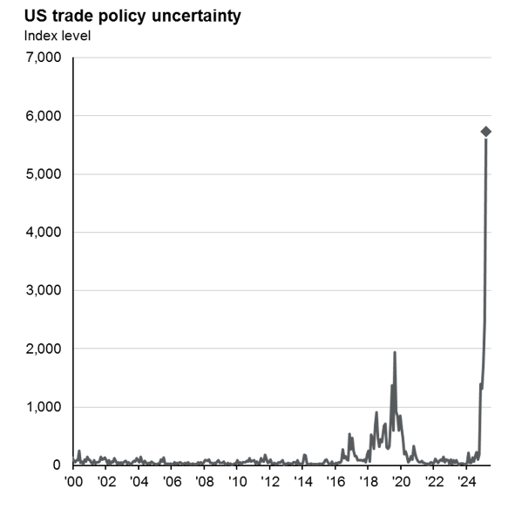
Economic indicators such as GDP growth and inflation trends have shown mixed signals. The final chart below shows market consensus 2025 GDP forecasts for the US (white), UK (blue), Eurozone (orange) and Japan (pink), with all to a greater or lesser extent having been downgraded since the start of the year. The US GDP growth forecast has suffered particularly heavily, falling from a relatively robust peak of c.2.3% in February 2025 down to 1.35% today, with the trajectory still downwards. This decline underscores the challenges faced by the US economy and others in maintaining growth momentum amidst external pressures.
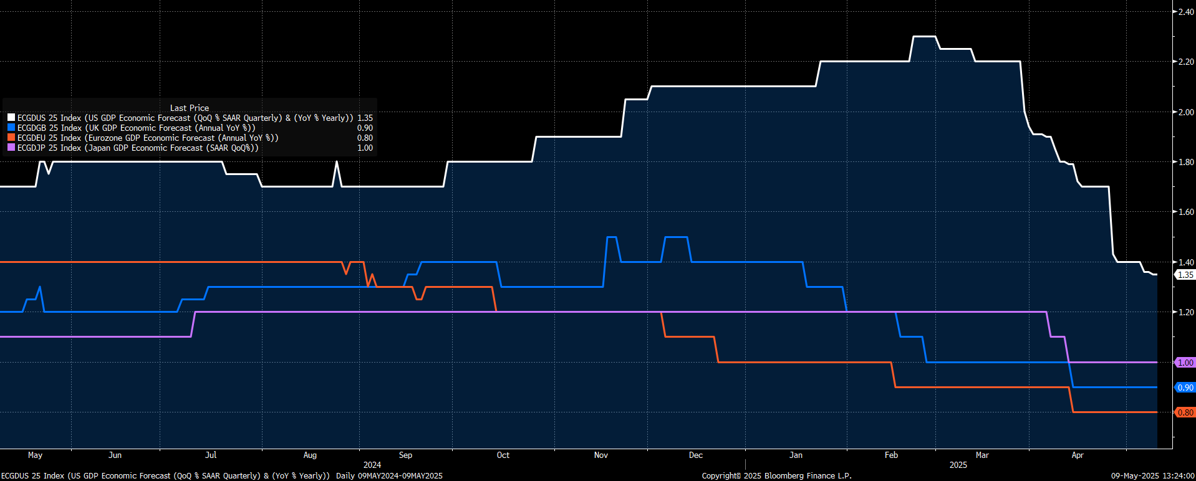
Looking ahead, financial markets’ drivers are expected to remain complex and dynamic, with several key factors shaping the investment landscape; most prominently the ongoing impact of US tariffs will continue to influence global trade policies, creating uncertainty and potential volatility. Additionally, central bank actions, including policy adjustments and rate cuts, will have significant implications for various asset classes. Understanding the direction of monetary policy will be important to adjust strategies accordingly.
As always, portfolio diversification will be crucial in mitigating risks associated with market fluctuations and economic instability. By adopting a strategic approach that emphasises diversification, we can help to guide you through these uncertain times and ensure that investment portfolios are well-positioned for long-term success.
To take a deeper dive into the update, listen to our Market Update podcast. In this episode, we explore April’s market performance highlights and discuss the broader economic developments that shaped investor sentiment, including government policy shifts and central bank responses around the world.
We have over 1250 local advisers & staff specialising in investment advice all the way through to retirement planning. Provide some basic details through our quick and easy to use online tool, and we’ll provide you with the perfect match.
Alternatively, sign up to our newsletter to stay up to date with our latest news and expert insights.
| Match me to an adviser | Our advisers |
The value of investments may fluctuate in price or value and you may get back less than the amount originally invested. Past performance is not a guide to the future. The views expressed in this publication represent those of the author and do not constitute financial advice.
March 2025 brought significant volatility across global markets, shaped by intensifying trade tensions, divergent central bank policies, and mounting recession concerns. Investor sentiment deteriorated as the US administration dramatically expanded tariffs targeting multiple trading partners, while fiscal developments in Europe and the UK highlighted contrasting approaches to economic challenges. The combination of increasing protectionism, sticky inflation, and slowing growth created a complex environment for investors navigating an increasingly uncertain global landscape.
Equities faced the brunt of the growing uncertainty around global trade and economic growth. major indices such as the S&P 500 extended their February correction, losing 8% in March, heavily impacted by technology and cyclical sectors reacting to escalating tariff threats and policy uncertainty. European equities also weakened, with the MSCI Europe index declining by -3.2%, driven by sluggish regional growth and heightened US trade tensions. Germany’s substantial fiscal stimulus announcement later in the month provided partial relief, particularly benefiting defence and infrastructure-related stocks.
In the UK, the FTSE All Share fell -2.6%, though larger-cap stocks provided relative resilience due to exposure in banks, defence, and commodities. Japanese equities fell by -3.6%, while broader Asian sentiment was mixed. Notably, Chinese equities held up well, losing only -0.5% despite ongoing trade concerns.
Bond markets saw volatility throughout March but held up relatively well, helped by a rally across most major indices in the final week. US government bonds gained 0.2%, as recession fears drove Treasury yields lower in a flight to safety and a repricing of Federal Reserve rate cuts this year. In Europe, bonds reacted negatively to Germany’s announced, “fiscal bazooka,” pushing Bund yields sharply higher towards 3%, and causing European government bonds to lose -1.7%. UK gilts also declined, by -1.2%, despite the Bank of England’s cautious easing stance.
Despite broader market volatility, corporate bonds displayed notable resilience, highlighting selective investor confidence in credit quality amidst macroeconomic uncertainties.
Currency markets reflected the broader themes playing out across economies in March. The US dollar weakened against all major currencies, as investors reassessed the demand for US assets given trade uncertainty and a weaker economy leading to more rate cuts. The Pound also weakened against the Euro, given the comments made above about how European Central Bank rates might also stay higher, alongside a stronger German economy at the heart of the region.
Trade policy dominated economic discussions in March, with the US administration aggressively expanding its tariff regime. Having already implemented tariffs against China, Canada, and Mexico in February, President Trump ordered a 25% tariff on autos and auto parts on March 26, effective April 3.
Initial tariffs announced on March 4 were somewhat watered down after negotiations, but tariff rates on US imports from Canada and Mexico have still ended up at double-digit levels. The market currently assumes 25% tariffs will be reimposed in April on imports from Canada and Mexico (with a lower 10% tariff on Canadian energy) alongside the steel, aluminium and China tariff.
Taken together, the overall US effective tariff rate is expected to significantly rise from its previous level – a dramatic shift that reverses several decades of trade globalisation. Markets are now bracing for further potential escalation, with additional “reciprocal tariffs” expected to be announced in early April, following what Trump describes as the United States’ “Liberation Day” on the 2nd. Investor concerns extend beyond the blunt tariffs currently being enforced or threatened, particularly given the ongoing uncertainty surrounding their exact nature, with plans appearing to shift almost daily. This volatile environment makes it extremely difficult for businesses and consumers to plan effectively, leading to delays in capital expenditure, hiring, investment, and broader spending. Such hesitation may result in knock-on effects further down the line.
All this uncertainty is already beginning to weigh on business and consumer confidence, as well as broader economic projections. In the Federal Reserve’s March meeting, they updated their projections for the end of 2025, shown below, lowering growth, while rising the rate of inflation and unemployment. However, it is important to note that these levels are still far from forecasting a recession and independent from political noise would be considered healthy.
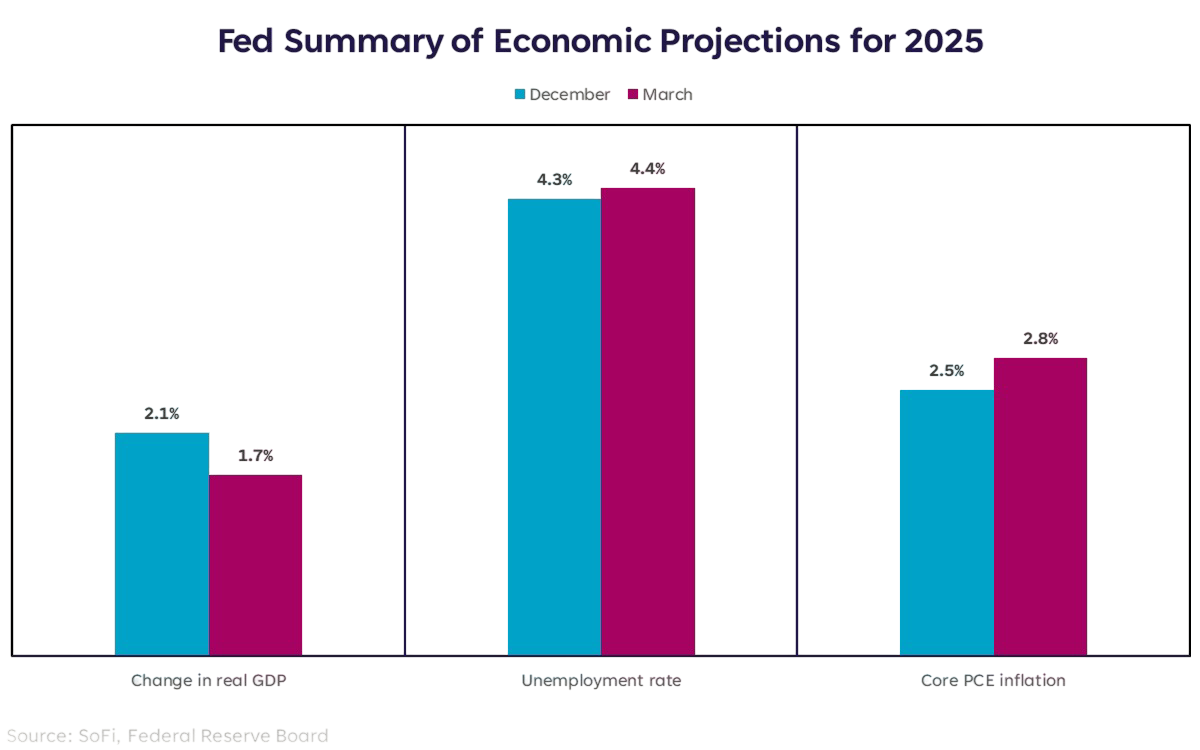
March brought a paradigm shift in European fiscal policy, centred on Germany’s massive stimulus announcement. The incoming CDU-SPD coalition government proposed an unprecedented fiscal expansion that quickly earned the nickname “fiscal bazooka”. The package totals approximately €500 billion (12% of 2024 GDP) and represents a dramatic departure from Germany’s traditional fiscal conservatism.
The plan includes widening the structural deficit allowed under Germany’s constitutional debt brake, exempting defence spending above 1% of GDP from deficit calculations, and creating a massive infrastructure fund outside the scope of the debt brake. This would fund a substantial increase in defence spending from just 1.3% of GDP in 2021 to around 3% by 2027, alongside accelerated €100 billion investment in transport, energy, and digital infrastructure.
This fiscal expansion is deemed significant enough to transform Germany’s economic outlook. Economists have substantially revised their projections upward, now expecting GDP growth to average 1.8% over the next four years – 0.7 percentage points higher than forecast just a month ago. However, this fiscal expansion also raises inflation concerns for the region.
The UK Spring Statement, delivered on March 26th, revealed a challenging economic outlook and limited fiscal flexibility. The Office for Budget Responsibility cut its 2025 GDP forecast to 1.0% (from 2%), though it projected improvement from 2026 onward with growth of 1.9% in 2026, 1.8% in 2027, 1.7% in 2028, and 1.8% in 2029.
Inflation is expected to follow a complex path – having fallen to 2.8% in February (the lowest since the inflation surge began), it’s projected to rise again to 3.8% by July before averaging 3.2% overall for 2025. The forecast then shows inflation falling to 2.1% in 2026 and reaching the Bank of England’s 2% target in 2027.
Chancellor Rachel Reeves announced approximately £10 billion in fiscal tightening to address a £14 billion deterioration in public finances since the October Budget. Despite this adjustment, fiscal headroom remains limited at just £9.9 billion – leaving little margin for error if economic conditions deteriorate further. Reeves also announced several spending priorities, such as defence expenditures and building social and affordable housing.
The global market and economic environment we find ourselves in presents a complex mix of challenges and opportunities. Escalating trade tensions, persistent inflation concerns, and mounting recession fears create headwinds, yet selective opportunities exist across asset classes for investors.
The key to navigating this uncertain landscape lies in diversification, across geographies, asset classes, sectors, and investment styles. By maintaining a balanced approach, focusing on quality, and remaining tactically flexible, investors can position portfolios to weather potential volatility while capturing opportunities as they emerge.
We have over 1250 local advisers & staff specialising in investment advice all the way through to retirement planning. Provide some basic details through our quick and easy to use online tool, and we’ll provide you with the perfect match.
Alternatively, sign up to our newsletter to stay up to date with our latest news and expert insights.
| Match me to an adviser | Our advisers |
The value of investments may fluctuate in price or value and you may get back less than the amount originally invested. Past performance is not a guide to the future. The views expressed in this publication represent those of the author and do not constitute financial advice.
February was another month of shifting dynamics in global markets, shaped by a mix of trade tensions, geopolitical uncertainty, and evolving policy expectations. Investor sentiment remained cautious as fresh U.S. tariffs targeted China, Canada, and Mexico, while diplomatic and political developments added to the complexity of the broader macroeconomic landscape.
Equity markets navigated these uncertainties with resilience in some cases, though performance varied by region. In the UK, stocks edged higher, supported by a more stable currency environment and strength in defensive sectors like consumer staples and utilities. Large-cap stocks outperformed their smaller counterparts as investors continued to favour established companies with strong balance sheets in a period of uncertainty. Across the Atlantic, U.S. markets carried their post-election momentum forward, though small caps struggled here too as concerns around tariffs and trade-sensitive sectors took hold.
Elsewhere, Chinese equities were by far the strongest performers over the month, driven higher by improved sentiment following more government pronouncements of support, and positivity following last month’s Deepseek announcement:
The bond market had its share of volatility, with government yields rising early in the month before stabilising as economic data came in softer than expected. In the U.S., concerns over higher spending and potential inflation pressures initially pushed yields higher, but by the latter half of February, those fears eased somewhat. Meanwhile, European bonds held firm, as investors sought safety amid political uncertainty in Germany, where the incumbent government was swept aside in elections. Credit markets remained relatively calm, with investment-grade corporate bonds attracting demand.
Currency markets reflected the broader themes playing out across economies. The U.S. dollar weakened as global trade risks grew, driven by President Trump’s wayward policy announcements. Sterling appreciated against most major currencies as GDP data surprised to the upside. The one currency it didn’t strengthen against was the Japanese yen in (-1.6%) as we saw hawkish comments from the Bank of Japan around interest rate rises, some very strong consumer spending & wages data, and some risk aversion coming back into market, for which the yen is a classic haven.
Trade remained a major point of focus, with the U.S. administration pushing forward with its plans to increase tariffs. A new 10% levy on Chinese imports, effective from early March, added to supply chain concerns, while additional tariffs on industrial metals are set to follow later in the month. Canada and Mexico were also hit with fresh trade restrictions, and there is growing speculation that European exports may soon face similar treatment. Investors will be watching closely to see if these measures escalate into broader retaliatory actions, particularly from China and the EU.
Beyond trade, geopolitical tensions showed no signs of easing. The Russia-Ukraine peace talks stalled, and with the risk of the U.S. withdrawing some level of support, uncertainty around the region deepened. In Europe, Germany’s elections reshaped the political landscape, and while coalition negotiations are ongoing, early signals point to a shift toward higher government spending and more pragmatic economic policies. Markets have so far reacted cautiously, waiting for further clarity.
Against this backdrop, as always, avoiding knee-jerk reactions to short-term market noise remains critical, and our portfolio positioning remains focused on stability, and long-term resilience through diversification.
We have over 1250 local advisers & staff specialising in investment advice all the way through to retirement planning. Provide some basic details through our quick and easy to use online tool, and we’ll provide you with the perfect match.
Alternatively, sign up to our newsletter to stay up to date with our latest news and expert insights.
| Match me to an adviser | Our advisers |
The value of investments may fluctuate in price or value and you may get back less than the amount originally invested. Past performance is not a guide to the future. The views expressed in this publication represent those of the author and do not constitute financial advice.
Global equity markets started the year on a positive note, recovering from the headwinds experienced towards the end of 2024. European equities rebounded sharply, posting gains of over 8% in January, following a challenging December driven by concerns around tariffs and weakness in key sectors. The FTSE 100 was another standout performer, rising nearly 6% and reaching an all-time high, marking its best monthly performance since November 2022.
Despite ending well, U.S. equities exhibited significant volatility, particularly in the final week of January, driven by a combination of earnings reports from major technology firms and a significant market shakeup caused by DeepSeek’s Artificial Intelligence (AI) breakthrough. The S&P 500 and Nasdaq saw substantial swings, reflecting the uncertainty around AI-related investments and potential disruptions to the current semiconductor landscape.
Emerging Markets and Asian equities underperformed relative to developed markets, despite exhibiting lower volatility levels. The FTSE 250 also struggled to keep pace with the broader market rally, highlighting continued economic uncertainty in the UK’s mid-cap space.
Bonds had a steadier and more positive month compared to late 2024, with corporate bonds outperforming government bonds. High-yield bonds led the way, reflecting continued investor appetite for risk in a more stable market environment.
Inflation-linked bonds also performed well, supported by concerns over inflation persistence, particularly in the U.S., where upcoming policy decisions and geopolitical risks weighed on sentiment. Market expectations for rate cuts in 2025 have moderated, with fewer cuts now priced in compared to earlier forecasts, leading to upward pressure on bond yields across major developed markets.
Notably, European government bonds were the weakest performer in the bond space, reflecting ongoing economic stagnation and political uncertainty. The European Central Bank (ECB) moved to cut rates to 2.75%, as expected, with markets anticipating similar action from the Bank of England in their February meeting. In contrast, the Federal Reserve opted to hold rates steady, reinforcing expectations of a “higher-for-longer” stance on U.S. interest rates.
The British Pound had a weak month, declining against most major currencies. This was primarily driven by weaker-than-expected economic growth in the UK and a shift in market expectations toward further interest rate cuts by the Bank of England, compared to just a few months ago. Meanwhile, the US dollar strengthened against most currencies, particularly in the latter part of the month, as the implementation of Trump’s proposed trade tariffs began in the final week.
A major event impacting markets in January was the unexpected impact of DeepSeek, a Chinese AI company that launched a highly competitive AI model at, reportedly, a fraction of the cost of its Western counterparts. This triggered widespread concern among investors regarding the sustainability of the heavy capital investments made by major technology firms in AI infrastructure.
The revelation that DeepSeek had trained its model using older and cheaper semiconductor chips sent shockwaves through the semiconductor sector, with Nvidia, in particular, losing nearly $600 billion in market capitalisation in a single session. To put the size of this move into context, only 14 listed companies in the world have a market capitalisation higher than the amount that Nvidia lost.
Despite this disruption, broader equity markets demonstrated resilience, with around 300 S&P 500 stocks remaining flat or positive despite the index’s overall decline, as shown in the chart below. This supports the view that equity market leadership is gradually broadening beyond the “Magnificent 7” tech stocks, a trend that may continue through 2025.
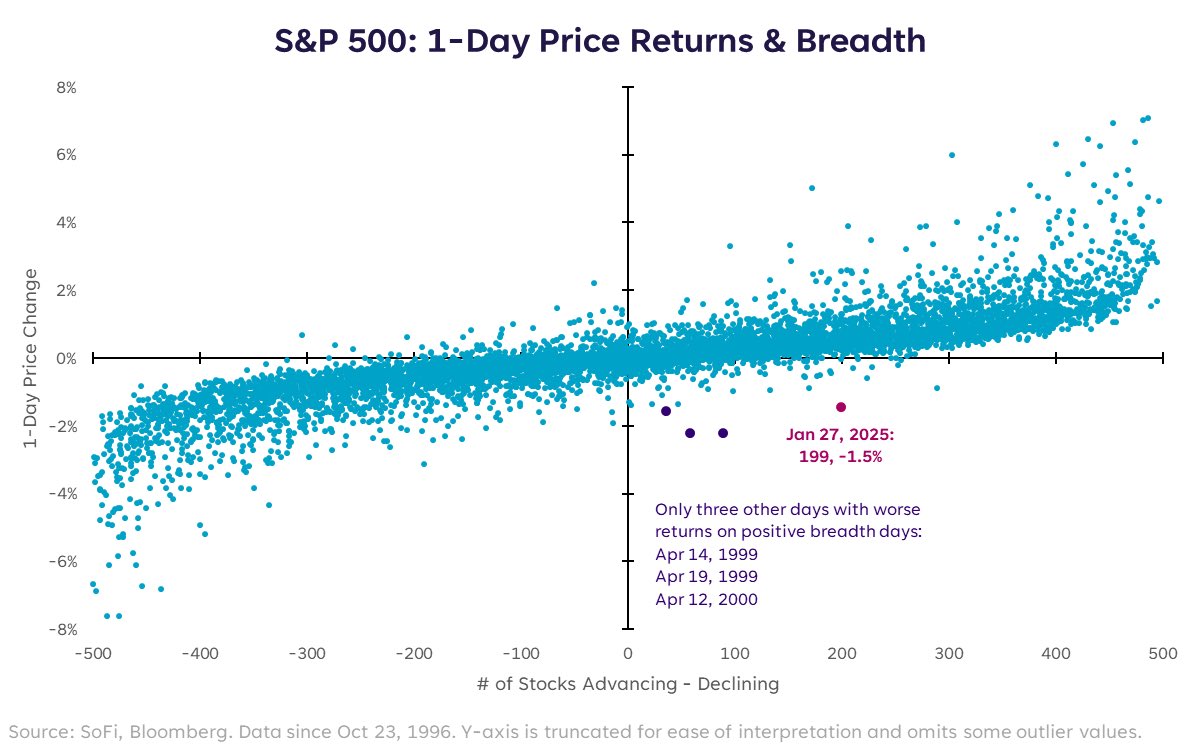
January also marked the beginning of President Trump’s second term, bringing with it immediate policy shifts that impacted market sentiment. His administration moved swiftly to implement tariffs, initially suggesting a postponement on Mexico and Canada before abruptly reversing course and imposing 25% tariffs on both nations. Additionally, a 10% tariff was levied on Chinese goods, with the possibility of further increases in the future.
These tariff measures have raised concerns over inflation, as the cost of imported goods will rise and consumers may feel the brunt of these increases. Early estimates suggest that tariffs on Canada and Mexico will have a more significant inflationary impact than those on China, given the changing trade flows since Trump’s first term.
There was, however, a large disparity between those rates cuts that were made and those that had been priced into markets as we came into 2024, which as the year progressed led to elevated levels of market volatility, and in the U.K., caused the Gilt Index to post another year of losses, closing down -3.0%.
Other major bond indices fared slightly better, with falling interest rates and continued economic resilience proving particularly constructive for credit markets, with the Global Aggregate Credit Index eking out an annual return of 3.6%. It was the Global High Yield Index that again gave bond investors the greatest returns though, adding 10.7% and exhibiting low levels of volatility through periods of changing interest rate expectations.
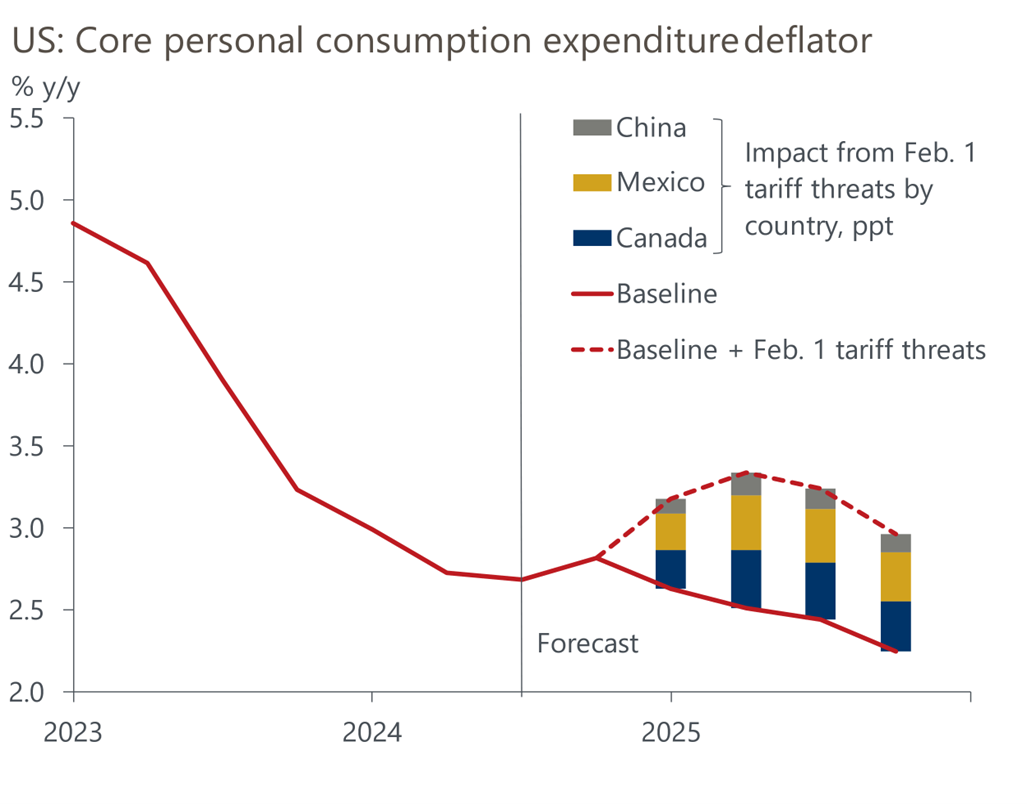
Alongside tariffs, stricter immigration controls were introduced, further tightening an already constrained U.S. labour market. With unemployment at historically low levels, these policies risk exacerbating labour shortages, which could drive wage inflation higher and impact the broader economy. Bond markets have already reacted to these developments, with yields rising in anticipation of prolonged inflationary pressures.
The unpredictability of Trump’s policies, particularly in trade and labour markets, has introduced a new layer of volatility to financial markets. Investors will need to remain adaptable as more clarity emerges on the administration’s long-term economic strategy.
January provided investors with a stark reminder of the importance of diversification and caution in navigating an increasingly complex global economic landscape. While equity markets started the year strong, volatility remains a key theme, particularly in the technology sector.
The bond market’s response to shifting inflation expectations and central bank policy decisions will continue to be a focal point, as investors weigh the impact of higher-for-longer interest rates against slowing global economic growth. Additionally, geopolitical risks, trade policy shifts, and evolving AI investment dynamics will be key factors influencing market direction in the coming months.
As we move further into 2025, maintaining a well-diversified approach and adapting to changing market conditions will be essential for investors seeking to manage risk while capitalising on the available opportunities.
If you want to take a deeper dive into the January update, listen to our Market Update podcast where we break down the latest on trade tensions, bond markets, interest rate shifts, and the headlines surrounding Deep Seek.
We have over 1250 local advisers & staff specialising in investment advice all the way through to retirement planning. Provide some basic details through our quick and easy to use online tool, and we’ll provide you with the perfect match.
Alternatively, sign up to our newsletter to stay up to date with our latest news and expert insights.
| Match me to an adviser | Our advisers |
The value of investments may fluctuate in price or value and you may get back less than the amount originally invested. Past performance is not a guide to the future. The views expressed in this publication represent those of the author and do not constitute financial advice.